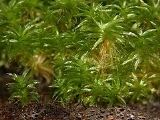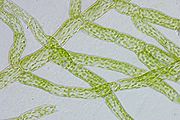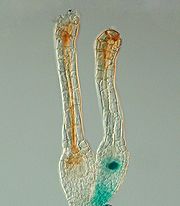
Physcomitrella patens
Encyclopedia
Physcomitrella patens is a moss
(Bryophyta) used as a model organism
for studies on plant evolution, development and physiology.
 Mosses share fundamental genetic and physiological processes with vascular plants, although the two lineages diverged early in land plant evolution. A comparative study between modern representatives of the two lines can give an insight into the evolution of the mechanisms behind the complexity of modern plants. It is in this context that Physcomitrella patens is used as a model organism
Mosses share fundamental genetic and physiological processes with vascular plants, although the two lineages diverged early in land plant evolution. A comparative study between modern representatives of the two lines can give an insight into the evolution of the mechanisms behind the complexity of modern plants. It is in this context that Physcomitrella patens is used as a model organism
.
Physcomitrella patens is one of a few known multicellular organisms with highly efficient homologous recombination
. meaning that an exogenous DNA
sequence can be targeted
to a specific genomic position (a
technique called gene targeting
) to create knockout mosses
. This approach is called reverse genetics
and it is a powerful and sensitive tool to study the function of genes
and,
when combined with studies in higher plants like Arabidopsis thaliana, can be used to study molecular plant evolution
.
The targeted deletion or alteration of moss genes relies on the integration of a short DNA
strand at a defined position in the genome
of the host cell. Both ends of this DNA strand are engineered to be identical to this specific gene locus. The DNA construct is then incubated with moss protoplast
s in the presence of polyethylene glycol
(PEG). As mosses are haploid organisms, the regenerating moss filaments (protonemata) can be directly assayed for gene targeting within 6 weeks using PCR methods. The first study using knockout moss appeared in 1998 and functionally identified ftsZ
as a pivotal gene for the division of an organelle
in a eukaryote
.
In addition, P. patens is increasingly used in biotechnology
. Examples are the identification of moss genes
with implications for crop
improvement or human health
and the safe production of complex biopharmaceutical
s in moss bioreactor
s. By multiple gene knockout
Physcomitrella plants were engineered that lack plant-specific post-translational protein glycosylation
. These knockout mosses are used to produce complex biopharmaceuticals in a process called molecular farming
.
The genome
of Physcomitrella patens, with about 500 megabase pairs organized into 27 chromosomes, was completely sequenced in 2006.
Physcomitrella ecotype
s, mutants, and transgenics are stored and made freely available to the scientific community by the International Moss Stock Center
(IMSC). The accession numbers
given by the IMSC can be used for publication
s to ensure safe deposit of newly described moss materials.
that produces gametes and 2) a diploid sporophyte
where haploid spores are produced.
A spore develops into a filamentous structure called protonema
, composed of two types of cells – chloronema with large and numerous chloroplasts and caulonema with very fast growth. Protonema filaments grow exclusively by tip growth
of their apical cells and can originate side branches from subapical cells. Some side branch initial cells can differentiate into buds rather than side branches. These buds give rise to gametophore
s (0.5 – 5 mm), more complex structures bearing leaf-like structures, rhizoids and the sexual organs: female archegonia and male antheridia. Physcomitrella patens is monoicous
, meaning that male and female organs are produced in the same plant. If water is available flagellate sperm cells can swim from the antheridia to an archegonium and fertilize the egg within.
The resulting diploid zygote originates a sporophyte composed of a foot, seta and capsule, where thousands of haploid spores are produced by meiosis
.
Moss
Mosses are small, soft plants that are typically 1–10 cm tall, though some species are much larger. They commonly grow close together in clumps or mats in damp or shady locations. They do not have flowers or seeds, and their simple leaves cover the thin wiry stems...
(Bryophyta) used as a model organism
Model organism
A model organism is a non-human species that is extensively studied to understand particular biological phenomena, with the expectation that discoveries made in the organism model will provide insight into the workings of other organisms. Model organisms are in vivo models and are widely used to...
for studies on plant evolution, development and physiology.
Model organism

Model organism
A model organism is a non-human species that is extensively studied to understand particular biological phenomena, with the expectation that discoveries made in the organism model will provide insight into the workings of other organisms. Model organisms are in vivo models and are widely used to...
.
Physcomitrella patens is one of a few known multicellular organisms with highly efficient homologous recombination
Homologous recombination
Homologous recombination is a type of genetic recombination in which nucleotide sequences are exchanged between two similar or identical molecules of DNA. It is most widely used by cells to accurately repair harmful breaks that occur on both strands of DNA, known as double-strand breaks...
. meaning that an exogenous DNA
DNA
Deoxyribonucleic acid is a nucleic acid that contains the genetic instructions used in the development and functioning of all known living organisms . The DNA segments that carry this genetic information are called genes, but other DNA sequences have structural purposes, or are involved in...
sequence can be targeted
Gene targeting
Gene targeting is a genetic technique that uses homologous recombination to change an endogenous gene. The method can be used to delete a gene, remove exons, add a gene, and introduce point mutations. Gene targeting can be permanent or conditional...
to a specific genomic position (a
technique called gene targeting
Gene targeting
Gene targeting is a genetic technique that uses homologous recombination to change an endogenous gene. The method can be used to delete a gene, remove exons, add a gene, and introduce point mutations. Gene targeting can be permanent or conditional...
) to create knockout mosses
Gene knockout
A gene knockout is a genetic technique in which one of an organism's genes is made inoperative . Also known as knockout organisms or simply knockouts, they are used in learning about a gene that has been sequenced, but which has an unknown or incompletely known function...
. This approach is called reverse genetics
Reverse genetics
Reverse genetics is an approach to discovering the function of a gene by analyzing the phenotypic effects of specific gene sequences obtained by DNA sequencing. This investigative process proceeds in the opposite direction of so-called forward genetic screens of classical genetics...
and it is a powerful and sensitive tool to study the function of genes
Gênes
Gênes is the name of a département of the First French Empire in present Italy, named after the city of Genoa. It was formed in 1805, when Napoleon Bonaparte occupied the Republic of Genoa. Its capital was Genoa, and it was divided in the arrondissements of Genoa, Bobbio, Novi Ligure, Tortona and...
and,
when combined with studies in higher plants like Arabidopsis thaliana, can be used to study molecular plant evolution
Evolution
Evolution is any change across successive generations in the heritable characteristics of biological populations. Evolutionary processes give rise to diversity at every level of biological organisation, including species, individual organisms and molecules such as DNA and proteins.Life on Earth...
.
The targeted deletion or alteration of moss genes relies on the integration of a short DNA
DNA
Deoxyribonucleic acid is a nucleic acid that contains the genetic instructions used in the development and functioning of all known living organisms . The DNA segments that carry this genetic information are called genes, but other DNA sequences have structural purposes, or are involved in...
strand at a defined position in the genome
Genome
In modern molecular biology and genetics, the genome is the entirety of an organism's hereditary information. It is encoded either in DNA or, for many types of virus, in RNA. The genome includes both the genes and the non-coding sequences of the DNA/RNA....
of the host cell. Both ends of this DNA strand are engineered to be identical to this specific gene locus. The DNA construct is then incubated with moss protoplast
Protoplast
Protoplast, from the ancient Greek πρῶτον + verb πλάθω or πλάττω , initially referred to the first organized body of a species.Protoplast has several biological definitions:...
s in the presence of polyethylene glycol
Polyethylene glycol
Polyethylene glycol is a polyether compound with many applications from industrial manufacturing to medicine. It has also been known as polyethylene oxide or polyoxyethylene , depending on its molecular weight, and under the tradename Carbowax.-Available forms:PEG, PEO, or POE refers to an...
(PEG). As mosses are haploid organisms, the regenerating moss filaments (protonemata) can be directly assayed for gene targeting within 6 weeks using PCR methods. The first study using knockout moss appeared in 1998 and functionally identified ftsZ
FtsZ
FtsZ is a protein encoded by the ftsZ gene that assembles into a ring at the future site of the septum of bacterial cell division. This is a prokaryotic homologue to the eukaryotic protein tubulin. FtsZ has been named after "Filamenting temperature-sensitive mutant Z". The hypothesis was that cell...
as a pivotal gene for the division of an organelle
Organelle
In cell biology, an organelle is a specialized subunit within a cell that has a specific function, and is usually separately enclosed within its own lipid bilayer....
in a eukaryote
Eukaryote
A eukaryote is an organism whose cells contain complex structures enclosed within membranes. Eukaryotes may more formally be referred to as the taxon Eukarya or Eukaryota. The defining membrane-bound structure that sets eukaryotic cells apart from prokaryotic cells is the nucleus, or nuclear...
.
In addition, P. patens is increasingly used in biotechnology
Biotechnology
Biotechnology is a field of applied biology that involves the use of living organisms and bioprocesses in engineering, technology, medicine and other fields requiring bioproducts. Biotechnology also utilizes these products for manufacturing purpose...
. Examples are the identification of moss genes
with implications for crop
Crop
Crop may refer to:* Crop, a plant grown and harvested for agricultural use* Crop , part of the alimentary tract of some animals* Crop , a modified whip used in horseback riding or disciplining humans...
improvement or human health
Health
Health is the level of functional or metabolic efficiency of a living being. In humans, it is the general condition of a person's mind, body and spirit, usually meaning to be free from illness, injury or pain...
and the safe production of complex biopharmaceutical
Biopharmaceutical
Biopharmaceuticals are medical drugs produced using biotechnology. They include proteins , nucleic acids and living microorganisms like virus and bacteria where the virulence of viruses and bacteria is reduced by the process of attenuation, they can be used for therapeutic or in vivo diagnostic...
s in moss bioreactor
Moss bioreactor
thumb|350px|Moss bioreactor with [[Physcomitrella patens]]A moss bioreactor is a photobioreactor used for the cultivation and propagation of mosses...
s. By multiple gene knockout
Gene knockout
A gene knockout is a genetic technique in which one of an organism's genes is made inoperative . Also known as knockout organisms or simply knockouts, they are used in learning about a gene that has been sequenced, but which has an unknown or incompletely known function...
Physcomitrella plants were engineered that lack plant-specific post-translational protein glycosylation
Glycosylation
Glycosylation is the reaction in which a carbohydrate, i.e. a glycosyl donor, is attached to a hydroxyl or other functional group of another molecule . In biology glycosylation refers to the enzymatic process that attaches glycans to proteins, lipids, or other organic molecules...
. These knockout mosses are used to produce complex biopharmaceuticals in a process called molecular farming
Molecular farming
Molecular farming is the use of genetically engineered crops to produce compounds with therapeutic value. These crops will become biological factories used to generate drugs and other difficult or expensive products...
.
The genome
Genome
In modern molecular biology and genetics, the genome is the entirety of an organism's hereditary information. It is encoded either in DNA or, for many types of virus, in RNA. The genome includes both the genes and the non-coding sequences of the DNA/RNA....
of Physcomitrella patens, with about 500 megabase pairs organized into 27 chromosomes, was completely sequenced in 2006.
Physcomitrella ecotype
Ecotype
In evolutionary ecology, an ecotype,Greek: οίκος = home and τύπος = type, coined by Göte Turesson in 1922 sometimes called ecospecies, describes a genetically distinct geographic variety, population or race within species , which is adapted to specific environmental conditions.Typically, ecotypes...
s, mutants, and transgenics are stored and made freely available to the scientific community by the International Moss Stock Center
International Moss Stock Center
The International Moss Stock Center , located at the Albert-Ludwigs-University of Freiburg, is an international resource center which is specialized in collecting, preserving and distributing moss plants of a high value of scientific research.-Moss collection:The moss collection of the IMSC...
(IMSC). The accession numbers
Accession number (bioinformatics)
An accession number in bioinformatics is a unique identifier given to a DNA or protein sequence record to allow for tracking of different versions of that sequence record and the associated sequence over time in a single data repository...
given by the IMSC can be used for publication
Publication
To publish is to make content available to the public. While specific use of the term may vary among countries, it is usually applied to text, images, or other audio-visual content on any medium, including paper or electronic publishing forms such as websites, e-books, Compact Discs and MP3s...
s to ensure safe deposit of newly described moss materials.
Life cycle
Like all mosses, the life cycle of Physcomitrella patens is characterized by an alternation of two generations: 1) a haploid gametophyteGametophyte
A gametophyte is the haploid, multicellular phase of plants and algae that undergo alternation of generations, with each of its cells containing only a single set of chromosomes....
that produces gametes and 2) a diploid sporophyte
Sporophyte
All land plants, and some algae, have life cycles in which a haploid gametophyte generation alternates with a diploid sporophyte, the generation of a plant or algae that has a double set of chromosomes. A multicellular sporophyte generation or phase is present in the life cycle of all land plants...
where haploid spores are produced.
A spore develops into a filamentous structure called protonema
Protonema
A protonema is a thread-like chain of cells that forms the earliest stage of a bryophyte life cycle...
, composed of two types of cells – chloronema with large and numerous chloroplasts and caulonema with very fast growth. Protonema filaments grow exclusively by tip growth
Tip growth
Tip growth is an extreme form of polarised growth of living cells that results in an elongated cylindrical cell morphology with a rounded tip at which the growth activity takes place. Tip growth occurs in algae , fungi and plants Tip growth is an extreme form of polarised growth of living cells...
of their apical cells and can originate side branches from subapical cells. Some side branch initial cells can differentiate into buds rather than side branches. These buds give rise to gametophore
Gametophore
The word gametophore, also known as gametangiophore, is composed of gametangium and "phore" . In moss and fern the gametophore is the bearer of the sex organs , the female archegonia and the male antheridia. If the archegonia as well as the antheridia are arranged at the same plant, they are...
s (0.5 – 5 mm), more complex structures bearing leaf-like structures, rhizoids and the sexual organs: female archegonia and male antheridia. Physcomitrella patens is monoicous
Monoicous
Monoicous is a botanical term used to describe plants which bear both sperm and eggs on the same gametophyte. Dioicous is the complementary term describing species in which gametophytes produce only sperm or eggs but never both. The terms are used largely but not exclusively in the context of...
, meaning that male and female organs are produced in the same plant. If water is available flagellate sperm cells can swim from the antheridia to an archegonium and fertilize the egg within.
The resulting diploid zygote originates a sporophyte composed of a foot, seta and capsule, where thousands of haploid spores are produced by meiosis
Meiosis
Meiosis is a special type of cell division necessary for sexual reproduction. The cells produced by meiosis are gametes or spores. The animals' gametes are called sperm and egg cells....
.
 |
External links
- The moss genome consortium homepage
- cosmoss.org - moss transcriptome and genome resource including genome browser
- The Japanese Physcomitrella transcriptome resource (Physcobase)
- The NCBI Physcomitrella patens genome project page
- JGI genome browser
- The moss Physcomitrella patens gives insights into RNA interference in plants
- A small moss turns professional
- Physcomitrella patens facts, developmental stages, organs at GeoChemBio
- http://www.tropicos.org/Name/35108841Tropicos.org. Missouri Botanical GardenMissouri Botanical GardenThe Missouri Botanical Garden is a botanical garden located in St. Louis, Missouri. It is also known informally as Shaw's Garden for founder Henry Shaw, a botanist and philanthropist.-History:...
.]

